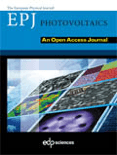
EPJ Photovoltaics
Scope & Guideline
Advancing solar innovation for a sustainable future.
Introduction
Aims and Scopes
- Photovoltaic Materials and Technologies:
Research on various photovoltaic materials, including silicon, perovskite, thin films, and organic solar cells, exploring their efficiencies, stability, and innovative fabrication methods. - System Performance and Optimization:
Studies aimed at optimizing the performance of photovoltaic systems, including modeling, forecasting, and real-time monitoring of solar energy generation under different environmental conditions. - Sustainability and Lifecycle Assessment:
Investigations into the environmental impacts of photovoltaic technologies, including lifecycle assessments, recycling strategies, and the integration of circular economy principles in solar energy deployment. - Advanced Characterization Techniques:
Utilization of advanced imaging, diagnostic, and characterization methods to assess the performance and reliability of photovoltaic modules and components. - Innovative Applications and Integration:
Exploration of novel applications of photovoltaic technology, such as building-integrated photovoltaics (BIPV), floating solar installations, and integration with other renewable energy sources.
Trending and Emerging
- Perovskite Solar Cells:
There is an increasing focus on perovskite solar cells, with studies investigating their fabrication, efficiency improvements, and stability. This trend is crucial as perovskites have the potential to revolutionize the solar energy landscape due to their high efficiency and lower production costs. - Machine Learning and AI Applications:
The application of machine learning and artificial intelligence to optimize photovoltaic system performance, including power forecasting and defect detection, is gaining momentum, showcasing the intersection of technology and renewable energy. - Bifacial and Floating Photovoltaics:
Research into bifacial solar panels and floating photovoltaic systems is on the rise, driven by their advantages in efficiency and land use, addressing the growing need for sustainable energy solutions in various environments. - Circular Economy in Photovoltaics:
Emerging studies prioritize circular economy strategies for photovoltaic deployment, focusing on recycling, material recovery, and sustainability, which are increasingly recognized as essential for the future of solar energy. - Advanced Performance Monitoring and Diagnostics:
The development of advanced monitoring techniques and diagnostic tools for evaluating photovoltaic performance under real-world conditions is trending, emphasizing the importance of reliability and efficiency in solar energy systems.
Declining or Waning
- Conventional Silicon Cell Technologies:
While silicon remains a dominant material, the frequency of publications specifically focused on traditional silicon solar cell technologies has decreased, possibly due to the emergence of more innovative materials like perovskites. - Basic Theoretical Studies:
The focus on purely theoretical approaches without practical application or experimental validation seems to be declining, as researchers increasingly seek to publish results that have direct implications for real-world applications. - Low-Efficiency Systems:
Research on low-efficiency photovoltaic systems or technologies that do not demonstrate significant advancements in efficiency or cost-effectiveness is becoming less prominent, as the community shifts toward higher-performance solutions.
Similar Journals
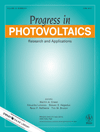
PROGRESS IN PHOTOVOLTAICS
Empowering Research in Renewable Energy TechnologiesPROGRESS IN PHOTOVOLTAICS, published by Wiley, is a leading scholarly journal dedicated to the advancement of photovoltaic technology and its applications. Since its inception in 1993, this journal has maintained a strong focus on the latest developments in solar energy, addressing both theoretical and practical aspects of photovoltaic systems. With an impressive impact factor and consistently ranked in the Q1 quartile across four key categories—Condensed Matter Physics, Electrical and Electronic Engineering, Electronic, Optical and Magnetic Materials, and Renewable Energy, Sustainability, and the Environment—PROGRESS IN PHOTOVOLTAICS is regarded as a pillar of scholarly excellence. The journal is essential for researchers, professionals, and students who seek to stay at the forefront of innovations and sustainability in the energy sector. Although it does not primarily offer open access, its commitment to advancing the understanding of photovoltaic technologies ensures that readers can expect high-quality, peer-reviewed research that pushes the boundaries of current knowledge.
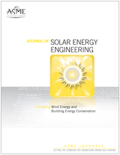
JOURNAL OF SOLAR ENERGY ENGINEERING-TRANSACTIONS OF THE ASME
Empowering Innovation in Solar Energy Engineering.JOURNAL OF SOLAR ENERGY ENGINEERING-TRANSACTIONS OF THE ASME is a premier publication dedicated to advancing the field of solar energy engineering, under the auspices of the prestigious American Society of Mechanical Engineers (ASME). With the ISSN 0199-6231 and E-ISSN 1528-8986, this journal has established itself as a critical resource for researchers and professionals alike, particularly in the areas of energy engineering and renewable technology. Currently enjoying an impact factor that places it in the Q2 category for Energy Engineering and Power Technology and Q3 for Renewable Energy, Sustainability, and the Environment, this journal effectively bridges impactful research and practical application. Spanning contributions from 1980 to 2025, the journal emphasizes empirical studies, innovative methodologies, and sustainable solutions that resonate with the growing global demand for renewable energy. The journal’s commitment to quality is reflected in its competitive Scopus rankings: 97th out of 272 in Energy Engineering and 124th out of 270 in Renewable Energy. Although not an Open Access journal, it remains a vital forum for disseminating research that shapes our energy future. Located in New York, this journal serves as a cornerstone for those in academia and industry to stay abreast of the latest advancements in solar energy technologies and their application in sustainable development.

Energy Materials
Unlocking the Potential of Materials for Energy Innovation.Energy Materials is a pioneering journal published by OAE PUBLISHING INC, dedicated to the dynamic field of energy materials science and engineering. With a focus on advancing knowledge related to materials used in various energy applications such as batteries, fuel cells, and solar cells, this open-access journal aims to disseminate cutting-edge research and innovative methodologies to a global audience. By offering a platform for original research, reviews, and case studies, Energy Materials plays a crucial role in bridging the gap between materials science and energy technology, facilitating the development of sustainable energy solutions. Researchers, professionals, and students alike will find invaluable insights in its pages, fostering advancements in this essential sector. To explore the latest developments in energy materials, visit Energy Materials at OAE PUBLISHING INC.
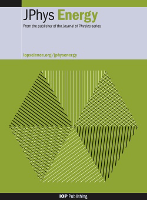
Journal of Physics-Energy
Advancing Energy Research for a Sustainable FutureJournal of Physics-Energy, published by IOP Publishing Ltd, is a leading Open Access journal that serves as a dynamic platform for the dissemination of high-quality research within the interdisciplinary realms of energy, materials science, and materials chemistry. Since its inception in 2019, the journal has gained remarkable recognition, achieving a prestigious Q1 ranking in multiple categories in 2023, highlighting its impact within these rapidly evolving fields. With its Scopus Ranks, placing it in the top 10% of journals for General Energy and within the top 20% for Materials Science disciplines, it reflects the commitment to excellence in research and innovation. Conveniently based in the United Kingdom, the journal is designed to facilitate collaboration and knowledge exchange among researchers, professionals, and students dedicated to advancing the understanding of energy technologies and materials science. The open access model ensures that cutting-edge research is freely available, promoting global accessibility and engagement with the latest scientific advancements.
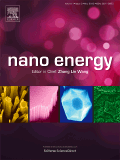
Nano Energy
Exploring the Future of Energy at the NanoscaleNano Energy is a premier journal published by Elsevier, focused on the dynamic intersection of nano-technology and energy solutions. Since its inception in 2012, this high-impact journal has made significant strides in advancing research across multiple disciplines, showcasing groundbreaking studies in Electrical and Electronic Engineering, Materials Science, and Renewable Energy. With an impressive Impact Factor that places it in the Q1 category of these fields—including a distinguished rank of #6 in Electrical Engineering and #9 in Renewable Energy on Scopus—the journal serves as a vital resource for academics and practitioners alike. Nano Energy aims to disseminate innovative research and developments that contribute to the sustainable energy landscape, thereby addressing pressing global energy challenges. Researchers and professionals seeking to stay at the forefront of nanotechnology applications in energy generation and efficiency will find this journal an indispensable platform for sharing knowledge and driving impact.
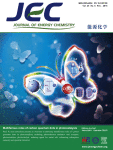
Journal of Energy Chemistry
Bridging Science and Sustainability in EnergyThe Journal of Energy Chemistry, published by Elsevier, is a premier international journal that has established itself at the forefront of research in the fields of electrochemistry and energy technology. With an impressive impact factor, this journal is classified in the Q1 quartile across multiple categories including Energy Engineering and Power Technology, Fuel Technology, and Electrochemistry, underscoring its significant contribution to advancing knowledge and innovation in energy systems. Based in the Netherlands, the journal offers open access to its cutting-edge research, allowing for broad dissemination and engagement among researchers, professionals, and students alike. The scope of the journal spans crucial topics from chemical energy storage to sustainable energy solutions, making it an essential resource for those looking to understand and contribute to the evolving landscape of energy chemistry.
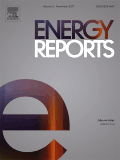
Energy Reports
Empowering Knowledge in the Evolving Energy LandscapeEnergy Reports, published by Elsevier, is a prestigious open access journal that serves as a vital resource in the field of energy research. Since its inception in 2015, this journal has swiftly ascended to become a key player in disseminating knowledge across various energy-related disciplines, evident from its impressive Q2 ranking in the miscellaneous category of Energy for 2023 and its notable position in the 78th percentile among over 70 journals in the general energy category, ranked 16th out of 73 on Scopus. Based in the United Kingdom, Energy Reports not only fosters innovative research but also promotes accessibility by providing open access to its articles, thereby ensuring that findings reach a global audience of researchers, professionals, and students. With a commitment to advancing sustainable energy solutions and technologies, Energy Reports plays a crucial role in shaping future energy policies and practices, making it an essential platform for scholarly communication in the ever-evolving landscape of energy research.

International Journal of Power and Energy Systems
Empowering Research in Energy InnovationInternational Journal of Power and Energy Systems, published by ACTA PRESS, serves as a vital platform for research and discourse in the multifaceted fields of applied mathematics, electrical and electronic engineering, and energy engineering. With an ISSN of 1078-3466 and an E-ISSN of 1710-2243, this journal covers a broad spectrum of topics pertinent to power and energy systems, showcasing innovative research from its inception in 1996 through to its projected contributions in 2024. Operating from Calgary, Canada, the journal, though not currently open access, provides invaluable insights into the challenges and advancements within these domains, as reflected in its categorization in the Q4 quartile across multiple indices. Despite being positioned in lower output percentiles in 2023 rankings on Scopus—specifically, #212 in Energy Engineering and Power Technology—it remains a critical resource for scholars seeking to expand the frontiers of knowledge in energy sustainability and system efficiency. Researchers, professionals, and students alike will find the journal’s commitment to fostering academic dialogue and disseminating pioneering results both essential and inspiring.

EUROPEAN PHYSICAL JOURNAL-APPLIED PHYSICS
Empowering Scientific Dialogue and InnovationEUROPEAN PHYSICAL JOURNAL-APPLIED PHYSICS, published by EDP SCIENCES S A in France, serves as a vital platform for the dissemination of cutting-edge research in the fields of condensed matter physics, electronic, optical and magnetic materials, and instrumentation. With an ISSN of 1286-0042 and E-ISSN of 1286-0050, this journal has been a valuable resource for researchers since its inception in 1998, aiming to foster innovation and dialogue among professionals and academics alike. Featuring an impact factor that reflects its growing influence, the journal is currently ranked in the Q4 quartile for several related categories in 2023, underscoring its ongoing contributions to the scientific community despite its relatively competitive positioning. Access to the journal is available through various Open Access options, ensuring that pioneering research is readily accessible to all. As it continues to evolve towards its 2024 objectives, EUROPEAN PHYSICAL JOURNAL-APPLIED PHYSICS remains dedicated to advancing knowledge and facilitating collaboration in applied physics, making it an essential resource for students, researchers, and professionals dedicated to exploring the forefront of physical sciences.

Solar RRL
Transforming sunlight into knowledge and innovation.Solar RRL, published by WILEY-V C H VERLAG GMBH in Germany, is a premier journal dedicated to advancing the field of solar energy research and technologies. With an impressive Q1 ranking across key disciplines—including Atomic and Molecular Physics, Electrical and Electronic Engineering, and Energy Engineering—this journal stands out as an authoritative source of high-impact research. Since its inception in 2017, Solar RRL has provided a platform for the dissemination of innovative ideas and findings, making vital contributions to the understanding of solar energy conversion, efficiency improvements, and sustainable technology. Researchers, professionals, and students seeking to stay at the forefront of solar energy advancements will find invaluable insights and rigorous studies in its pages. Although currently not an open-access journal, Solar RRL offers a subscription model that gives readers access to cutting-edge research that shapes the future of energy technology.